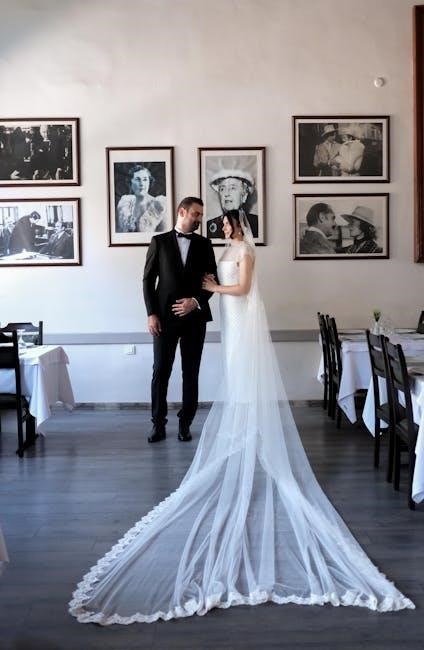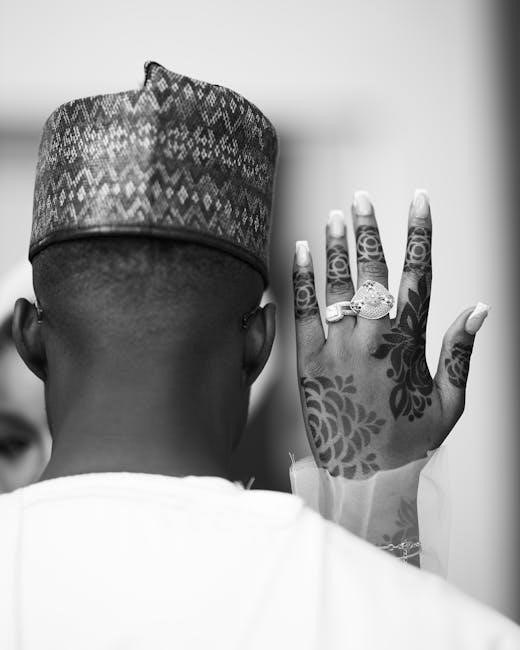Happiness in marriage is not automatic but must be created through effort and dedication. It involves valuing the little things and nurturing love consistently over time.
1.1 Defining the Art of Marriage
The art of marriage is the intentional cultivation of love, respect, and harmony between partners. It involves creating happiness through shared efforts, valuing small gestures, and nurturing emotional connections. Marriage is a legally recognized union that requires commitment, understanding, and mutual growth, fostering a meaningful and enduring relationship.
1.2 Historical Context of Marriage as a Vocation
Marriage has historically been viewed as a sacred vocation, rooted in religious and cultural traditions. It is often seen as a divine institution, requiring commitment, loyalty, and mutual support. The concept of marriage as a calling emphasizes its purpose in fostering love, stability, and family life, reflecting societal values and expectations across generations and cultures.
Key Principles of a Successful Marriage
Happiness in marriage is created through consistent effort, commitment, and mutual respect, fostering a lasting and fulfilling journey together.
2.1 Happiness in Marriage as a Created Process
Happiness in marriage is not something that simply happens; it is a process that requires effort, commitment, and mutual respect. Both partners must actively nurture their relationship by valuing the little things and consistently showing love and appreciation. Marriage is a journey of growth, where couples learn to navigate life’s challenges together, fostering a deeper connection and lasting fulfillment.
As emphasized in The Art of Marriage, it is never too late to hold hands or express affection, as these small gestures sustain the bond and create a foundation for enduring happiness.
2.2 The Importance of Little Things in Building a Strong Relationship
The art of marriage emphasizes that small gestures, like holding hands or expressing gratitude, are vital in nurturing a strong bond. These little acts of love and care create a foundation of trust and connection, fostering a deeper relationship over time.
By prioritizing shared moments and thoughtful surprises, couples can keep their relationship vibrant and meaningful, ensuring that love remains a central part of their journey together.

Communication in Marriage
Effective communication is the cornerstone of a harmonious marriage. It involves both verbal and non-verbal techniques that foster understanding and maintain emotional connection and trust.
3.1 The Role of Effective Communication in Maintaining Harmony
Effective communication fosters understanding and empathy, serving as the foundation for harmony in marriage. By actively listening and expressing thoughts clearly, couples can resolve conflicts and strengthen their bond, ensuring a deeper connection and mutual respect. Open dialogue helps navigate challenges, preventing misunderstandings and fostering a supportive environment for both partners to thrive.
3.2 Verbal and Non-Verbal Communication Techniques
Verbal techniques involve clear expression of thoughts and emotions, while non-verbal cues like body language and eye contact convey unspoken feelings. Both are essential in marriage, as they enhance understanding and intimacy. Active listening and empathetic responses strengthen connections, ensuring that both partners feel heard and valued, fostering a harmonious and loving relationship through consistent and thoughtful communication practices.

The Role of Love and Affection
Love and affection are the foundation of a successful marriage, cultivated through effort and dedication. They nurture emotional bonds, fostering intimacy and mutual support, essential for a lasting relationship.
4.1 Understanding the Concept of Love in Marriage
Love in marriage is a profound and multifaceted concept that evolves over time. It encompasses emotional connection, mutual respect, and unwavering commitment. True love is not merely a feeling but a choice that requires effort, patience, and understanding. In the context of marriage, it serves as the glue that binds two individuals together, fostering a deep and lasting bond. This enduring connection is essential for navigating life’s challenges side by side.
4.2 The Significance of Intimacy and Emotional Connection
Intimacy and emotional connection are vital in marriage, fostering a deeper bond between partners. Physical closeness strengthens trust and affection, while emotional intimacy ensures open communication and mutual understanding. These elements create a safe and nurturing environment, allowing couples to grow together and overcome challenges. They are essential for maintaining a healthy and fulfilling relationship, as highlighted in various resources on the art of marriage.

Conflict Resolution in Marriage
Conflict resolution in marriage requires strategies like active listening, understanding, and compromise. Focusing on the present issue fosters mutual respect and strengthens the relationship.
5.1 Strategies for Resolving Conflicts Constructively
Effective conflict resolution involves staying calm, avoiding blame, and focusing on solutions. Active listening and expressing feelings with “I” statements help prevent escalation. Compromise and mutual respect are key to finding balance and understanding. Addressing issues promptly ensures they don’t fester, fostering a healthier relationship and strengthening the bond between partners.
5.2 The Importance of Forgiveness and Understanding
Forgiveness is essential for healing and moving forward in marriage. It involves letting go of resentment and choosing to understand each other’s perspectives. Understanding fosters empathy and strengthens emotional bonds, allowing couples to navigate challenges with compassion. Forgiveness doesn’t erase conflicts but creates space for growth, ensuring the relationship remains resilient and harmonious over time.
Commitment and Teamwork in Marriage
Commitment and teamwork form the foundation of a successful marriage, requiring mutual support and shared goals to foster a lasting partnership.
6.1 Building a Lasting Commitment to One Another
Building a lasting commitment requires mutual dedication, trust, and shared goals. It involves choosing to prioritize your partner daily, fostering a bond that grows stronger over time.
6.2 The Role of Mutual Support and Teamwork
Mutual support and teamwork are the backbone of a thriving marriage. Both partners contribute equally, fostering a sense of unity and shared purpose. Emotional backing, shared responsibilities, and collaborative problem-solving strengthen the bond. Teamwork ensures resilience, enabling couples to navigate life’s challenges together, creating a foundation of trust, understanding, and enduring partnership.
The Role of Respect and Trust
Respect and trust form the cornerstone of a successful marriage, fostering mutual understanding and emotional security. They build a foundation where both partners feel valued and supported.
7.1 Understanding the Importance of Respect in Marriage
Respect in marriage is about valuing each other’s thoughts, feelings, and individuality. It creates a safe environment for open communication and mutual appreciation. When both partners respect one another, they foster a culture of empathy and understanding, which strengthens the bond and promotes harmony. Respect is not just an action but a fundamental attitude that nurtures a thriving relationship.
7.2 Building and Maintaining Trust
Trust is the cornerstone of a strong marriage, requiring transparency and consistency. It is built through honest communication, reliability, and fulfilling commitments. Consistently acting with integrity reinforces trust, while betrayal can erode it. Maintaining trust involves ongoing effort, mutual support, and addressing conflicts openly. A trusting relationship fosters security, allowing partners to grow together with confidence and mutual reliance.

Creating Shared Meaning in Marriage
Shared meaning in marriage is built through common goals, values, and traditions. It involves creating rituals and fostering teamwork, strengthening the bond and purpose of the relationship.
8.1 The Role of Shared Goals and Values
Shared goals and values form the foundation of a meaningful marriage. They provide direction and purpose, fostering unity and cooperation. Aligning on life priorities strengthens commitment, creating a harmonious partnership focused on mutual objectives and enduring principles, which enriches the relationship and builds resilience through life’s challenges together.
8.2 Celebrating Traditions and Rituals Together
Celebrating traditions and rituals strengthens marital bonds, fostering a sense of closeness and shared identity. Whether cultural, religious, or personal, these practices create meaningful moments and lasting memories. They provide a sense of continuity and connection, allowing couples to honor their heritage while building new customs together, enriching their relationship and deepening mutual understanding and appreciation over time.
The Role of Independence Within Marriage
Maintaining personal identity and independence is crucial for a healthy marriage, fostering mutual respect and allowing each partner to grow individually while supporting each other’s development.
9.1 Maintaining Personal Identity
Maintaining personal identity in marriage is essential for a balanced relationship. Each partner should retain their individuality, pursue personal interests, and nurture self-growth. This fosters mutual respect and prevents codependency, allowing both individuals to contribute uniquely to the marriage. By preserving personal identity, couples can maintain a healthy dynamic and support each other’s evolution over time.
9.2 Encouraging Personal Growth and Development
Encouraging personal growth in marriage fosters a fulfilling relationship. Partners should support each other’s goals, embrace new experiences, and celebrate individual achievements. Continuous learning and self-improvement strengthen the bond and create a dynamic partnership. By nurturing each other’s aspirations, couples can grow together while maintaining their unique identities, leading to a more enriched and harmonious marriage over time.

Financial Harmony in Marriage
Financial harmony in marriage requires teamwork, transparency, and mutual respect. Managing finances together builds trust and stability, key to a lasting, happy relationship.
10.1 Managing Finances Together
Managing finances together involves open communication, shared goals, and mutual accountability. Couples should create a budget, discuss spending habits, and make financial decisions collaboratively. This fosters trust and ensures both partners are committed to their financial well-being. Regular discussions about money help prevent conflicts and strengthen the bond, creating a secure future together.
10.2 The Importance of Financial Independence
Financial independence within marriage fosters security and reduces stress. Maintaining individual financial autonomy allows both partners to make personal spending decisions without guilt. It ensures that each partner feels empowered and secure, even as they work together on shared financial goals. This balance supports mutual respect and confidence in managing finances, strengthening the relationship overall.

Navigating Relationships with In-Laws
Maintaining healthy relationships with in-laws requires setting boundaries and fostering mutual respect. Open communication and cooperation help create a harmonious extended family dynamic without compromising personal values.
11.1 Setting Boundaries
Setting boundaries with in-laws is crucial for maintaining marital harmony. Establishing clear expectations regarding visits, advice, and decision-making helps protect privacy and reduces potential conflicts. Open communication with both partners ensures alignment on these boundaries, fostering respect and understanding within the extended family. Balancing love and respect for in-laws while prioritizing the marriage is essential for a healthy relationship dynamic.
11.2 Maintaining a Healthy Relationship with Extended Family
Maintaining a healthy relationship with extended family requires balancing involvement and independence. Mutual respect, open communication, and respecting boundaries foster harmony. Sharing traditions and rituals can strengthen bonds, while also allowing personal space. Encouraging understanding and empathy helps navigate differences, ensuring a supportive and loving environment for all family members without compromising the core marital relationship.

Parenting and Marriage
Parenting profoundly impacts marriage, requiring teamwork and communication to maintain a healthy relationship while raising children, ensuring mutual support and shared responsibilities strengthen the bond between partners.
12.1 The Impact of Parenting on Marriage
Parenting introduces new challenges, shifting focus from the marital relationship to childcare, often straining emotional and physical resources. Balancing responsibilities requires teamwork, while financial pressures and sleep deprivation can test intimacy. Open communication and shared responsibilities are essential to maintain a strong bond, ensuring both partners feel supported and valued amidst the demands of raising children.
12.2 Co-Parenting Strategies
Effective co-parenting involves maintaining open communication, consistency in parenting styles, and shared responsibilities. It requires balancing discipline with emotional support while fostering a united front. Scheduling quality time as a couple ensures intimacy and connection are preserved. By prioritizing teamwork, parents can create a stable environment for their children while nurturing their marital relationship, ensuring both partners feel valued and supported.
The Role of Personal Growth and Evolution
Personal growth strengthens the marital bond by fostering emotional and intellectual development. Continuous learning and evolution enable couples to adapt and grow together, enriching their relationship.
13.1 Embracing Change Together
Embracing change together is essential for a thriving marriage. As individuals grow, so must the relationship. Adapting to life’s challenges and opportunities strengthens the bond. Open communication and mutual support foster resilience. Change, when navigated collectively, leads to personal and relational growth, enriching the partnership. It requires flexibility, understanding, and a shared commitment to evolving together, ensuring the marriage remains vibrant and fulfilling over time.
13.2 The Importance of Continuous Learning and Development
Continuous learning and development are vital for fostering personal and relational growth in marriage. Engaging in new experiences, such as reading, courses, or hobbies, enriches both individuals and the relationship. This shared pursuit of knowledge and self-improvement strengthens intellectual and emotional connections, keeping the marriage dynamic and resilient. Learning together encourages adaptability, understanding, and mutual support, ensuring the relationship remains vibrant and evolving over time.

The Influence of Culture and Religion
Culture and religion significantly shape marriage dynamics, influencing rituals, values, and practices. They provide ethical frameworks and meanings, enriching the marital bond and fostering harmony.
14.1 Cultural Influences on Marriage
Cultural traditions deeply impact marriage, shaping rituals, expectations, and family roles. They define ceremonies, gender dynamics, and social norms, creating a unique framework for each couple. These influences often guide communication styles and conflict resolution, fostering a sense of community and shared identity. By embracing cultural practices, couples can strengthen their bond and honor their heritage.
14.2 The Role of Religious Teachings in Shaping Marriage
Religious teachings profoundly shape marriage by providing moral guidelines, defining roles, and fostering commitment. Many faiths emphasize love, respect, and unity, influencing how couples interact and resolve conflicts. For instance, Sheikh Albani’s teachings highlight Islamic etiquettes, while Catholic doctrines define marriage as a sacred union. These principles often inspire mutual support and devotion, strengthening the marital bond and guiding couples toward a harmonious life together.

Incorporating Traditions and Rituals
Incorporating traditions and rituals enriches the marital bond by connecting couples to shared heritage and fostering a deeper sense of unity and commitment.
15.1 The Significance of Cultural and Religious Traditions
Cultural and religious traditions play a vital role in shaping marital values, providing a shared identity and moral framework for couples. They offer rituals and practices that strengthen commitment, foster unity, and create lasting memories, while respecting heritage. These traditions often serve as a foundation for mutual respect and understanding, enriching the marital journey.
15.2 Creating Personal Rituals to Strengthen the Marriage
Personal rituals, such as weekly date nights or shared moments of reflection, can deeply strengthen a marriage. These customs, tailored to the couple’s preferences, foster intimacy and connection. They create a sense of continuity and togetherness, helping partners stay emotionally and spiritually aligned. By prioritizing these practices, couples can build a resilient and meaningful bond that endures through life’s challenges.
Marriage is a beautiful journey requiring continuous effort, understanding, and love. By nurturing relationships and embracing growth, couples can build a lasting and fulfilling partnership together.
16.1 The Ongoing Journey of Marriage
Marriage is a lifelong journey that requires commitment, understanding, and mutual growth. It involves embracing challenges together, adapting to change, and nurturing love consistently. By prioritizing communication, respect, and teamwork, couples can fostering a deepening bond and create a fulfilling partnership that evolves beautifully over time, reflecting the art of marriage as a shared and ongoing endeavor.
16.2 Final Thoughts on Nurturing a Successful Marriage
Nurturing a successful marriage requires continuous effort, mutual respect, and a commitment to growth. By valuing the little things, fostering intimacy, and maintaining open communication, couples can build a lasting bond. Embracing change, learning together, and prioritizing trust form the foundation of a fulfilling partnership. Marriage, as an art, flourishes when both partners dedication to creating happiness and harmony endures;
Additional Resources
Explore The Art of Marriage PDF for insights. Discover Wilferd Arlan Peterson’s timeless advice and Catherine Blythe’s anecdotes for a deeper understanding of marital harmony.
17.1 Recommended Reading on the Art of Marriage
The Art of Marriage by Wilferd Arlan Peterson is an essential read, blending wisdom and poetry to guide couples. Catherine Blythe’s anecdotes offer real-life insights, while Erich Fromm’s The Art of Loving explores deeper connections. These works, available in PDF formats, provide timeless advice for nurturing love, communication, and mutual respect, enriching your marital journey with practical and heartfelt guidance.
